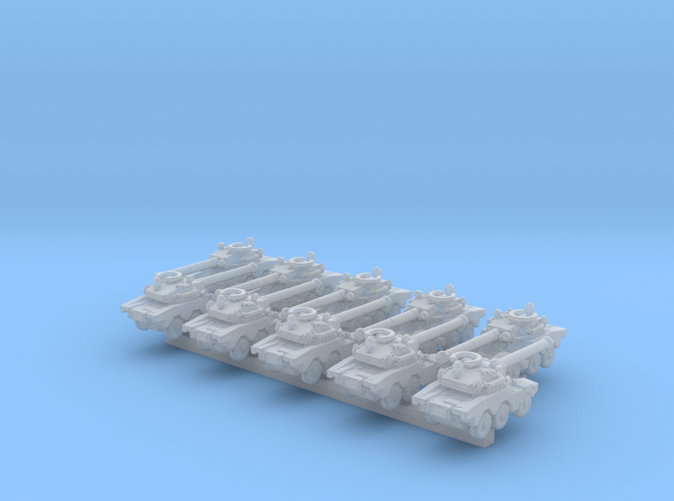1/700 Scale Modern French Panhard ERC-90 F4 Armoured All-Terrain Vehicle x10.
Contains 10 highly detailed tanks.
Contains:- 10x French Panhard ERC-90 F4 Armoured All-Terrain Vehicles
Panhard ERC-90 F4 Armoured All-Terrain Vehicle
The
Panhard ERC 90 (
Engin à Roues, Canon de 90 mm) is a French six-wheeled
armoured all-terrain vehicle which is highly mobile and amphibious with an option of being
NBC-proof. While various models were tested, only two versions of the ERC were developed and produced: the
Lynx and the
Sagaie. The main difference between the two versions is the type of turret and 90 mm gun fitted.
Sagaie is French for
assegai, a type of African
spear.Shortly after the ERC 90 F1 Lynx had been built for export, Panhard recognized the need for a cost-effective light armoured vehicle that could defeat a more modern main battle tank (MBT), like the Russian T-72 which was being exported to many nations.[
citation needed] The
Lynx version could only fire medium-velocity
HEAT rounds in the anti-tank role, which lacked the penetration to defeat the more modern MBTs. Panhard designed a turret which mounted the long barrel F4 90mm smooth bore-cannon developed by GIAT, and designated the vehicle the ERC 90 F4
Sagaie. The F4 90mm could fire
APFSDS (Armour Piercing Fin Stabilised Discarding Sabot) rounds at a much higher velocity than the Lynx's F1 90mm; GIAT and Panhard both claimed it could penetrate heavy armour at 2000 metres. For a while, GIAT engineers could not find a suitable muzzle brake for the
Sagaie which would not interfere with the firing of APFSDS rounds, but finally found a suitable solution using a muzzle brake design from the older
AMX-13 tank.
[4]
Ivory Coast was the first export customer, ordering five
Sagaies to replace its aging AMX-13s in the light armour role. At this time period, the French Army was organising the Fast Deployment Force (FDF) for overseas military missions, mainly in Africa or the Middle East. The main core of the FDF would be French Army's 9th Marine Infantry Division and 11th Parachute Division.
[6] To make the new FDF "more muscular" a new unit was activated, the 31st Heavy Half Brigade (31 DBL) of two regiments. One regiment was to be armed with vehicles mounting the
HOT wire-guided missile, and the other with cannon-armed vehicles that could provide both reconnaissance and a limited tank-killing role.
The ERC-90 F4 Sagaie variant – The French Army had at first planned on equipping the second regiment with the
AMX-10RC, but were told that this vehicle was not suitable for transport by the French Air Force
Transall C-160 or its allies'
Hercules C-130 aircraft due to size and weight issues. In addition, most of the bridges in Africa had only a 6 to 8 ton load capacity. So instead of the larger AMX-10RC, which was already in service with the French Army, the French Army Staff took the surprise step in December 1980 of ordering the
Sagaie for the future FDF. And to date the
Sagaie has proved very useful for the French Army in its African bases and even in urban conditions during the
Siege of Sarajevo. The last known combat use of the
Sagaie was with French troops stationed in Ivory Coast on a peace-keeping
Cleaning Information
Some part cleanup will be necessary. The 3D printing process uses a waxy substance to support certain part features during the printing process. Although the parts are cleaned by Shapeways, some waxy residue may remain. It can be safely removed with water and a mild aqueous detergent like "Simple Green" using an old, soft toothbrush, Q-tips or pipe cleaners. During the printing process, liquid resin is cured by ultraviolet light. Microscopic bits of resin may remain uncured.
Let your parts sit in direct sunlight for a few hours to fully cure the resin.
Water-based acrylic paints meant for plastics is strongly recommended. Other paints, especially enamels, may not cure on Frosted Detail 3D-printed plastics.
Use dedicated model sprue cutters to remove parts to minimise the risk of damage to parts.
Please take a look at my other items.
Painting tips and preparation
